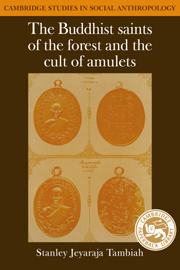Book contents
- Frontmatter
- Contents
- Acknowledgments
- Note on transcription
- 1 Introduction and manifesto
- Part I The arahant and the Path of Meditation
- Part II The hagiography of a Buddhist saint: text and context; the politics of sectarianism
- Part III The cult of amulets: the objectification and transmission of charisma
- 14 The cult of images and amulets
- 15 An enumeration of historic and popular amulets
- 16 The “likeness” of the image to the original Buddha: the case of the Siṅhala Buddha
- 17 The process of sacralizing images and amulets: the transfer of power by monks
- 18 Amulets blessed by contemporary forest saints
- 19 Saints on cosmic mountains
- Part IV Conceptual and theoretical clarifications
- Notes
- Index
- CAMBRIDGE STUDIES IN SOCIAL ANTHROPOLOGY
17 - The process of sacralizing images and amulets: the transfer of power by monks
Published online by Cambridge University Press: 10 December 2009
- Frontmatter
- Contents
- Acknowledgments
- Note on transcription
- 1 Introduction and manifesto
- Part I The arahant and the Path of Meditation
- Part II The hagiography of a Buddhist saint: text and context; the politics of sectarianism
- Part III The cult of amulets: the objectification and transmission of charisma
- 14 The cult of images and amulets
- 15 An enumeration of historic and popular amulets
- 16 The “likeness” of the image to the original Buddha: the case of the Siṅhala Buddha
- 17 The process of sacralizing images and amulets: the transfer of power by monks
- 18 Amulets blessed by contemporary forest saints
- 19 Saints on cosmic mountains
- Part IV Conceptual and theoretical clarifications
- Notes
- Index
- CAMBRIDGE STUDIES IN SOCIAL ANTHROPOLOGY
Summary
We now come to the rituals of sacralization of amulets and the process by which potency and efficacy are transferred by the monks to the amulets. The actual sequence may vary from ceremony to ceremony, as we shall see in the illustrations below, but the underlying mechanisms are the same, in that there is a chanting of sacred words (sēk khāthā), the transferring of potency by sitting in meditation (nang prok), and the like. Moreover, the sacralization of amulets is essentially similar to the chanting and transference procedures by which Buddha statues are ceremonially installed and “animated” by the “opening of the eyes” (bōēk phranēt). As a matter of fact, it is a common practice that, when a Buddha statue is being sacralized at a wat, the laity (and monks) will bring small statues newly purchased or cast, and their favorite amulets, so that they too can undergo the rite. The ritual procedures highlight an important fact about consecrations and installations. The Buddha cannot become immanent in a statue until his “presence” has been activated by monks by their recitations of the Dhamma and by the transfer of their spiritual virtues and energies as followers of the Path. Similarly, although amulets in the shape of an animal, bird, human, or deity have certain virtues related to their form and intrinsic nature, it is the monk and lay specialist who importantly charge them with efficacy. This double aspect of installation has to be kept in view. The gods and other suprahuman agents are nonentities without their worshipers and officiants, just as the latter have no identities without their gods and collective representations.
- Type
- Chapter
- Information
- The Buddhist Saints of the Forest and the Cult of Amulets , pp. 243 - 257Publisher: Cambridge University PressPrint publication year: 1984

